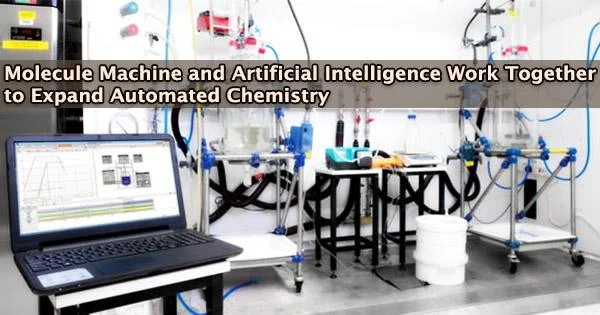The best general reaction conditions for synthesizing chemicals important to biomedical and materials research were discovered by combining artificial intelligence (AI), “building-block” chemistry, and a molecule-making machine. This discovery may speed innovation and drug discovery as well as make complex chemistry automated and approachable.
Researchers from the University of Illinois Urbana-Champaign and associates from Poland and Canada increased the average yield of a unique, challenging-to-optimize type of reaction joining carbon atoms together in pharmaceutically significant compounds using the machine-generated optimum settings.
According to the researchers, their method offers a platform that might be used to discover general conditions for other types of reactions and answers to situations that are similarly challenging. They published their research in the Science publication.
“Generality is critical for automation, and thus making molecular innovation accessible even to nonchemists,” said study co-leader Dr. Martin D. Burke, an Illinois professor of chemistry and of the Carle Illinois College of Medicine, as well as a medical doctor.
“The challenge is the haystack of possible reaction conditions is astronomical, and the needle is hidden somewhere inside. By leveraging the power of artificial intelligence and building-block chemistry to create a feedback loop, we were able to shrink the haystack. And we found the needle.”
However, many chemicals that are significant for pharmaceutical, clinical, manufacturing, and materials applications are small molecules with complex structures, according to the researchers. This is because automated synthesis machines for proteins and nucleic acids like DNA have revolutionized research and chemical manufacturing in those fields.
There are all kinds of building block combinations that we didn’t even study in our AI training, but because the AI had explored such a diverse space, it found good results even in those initially unexplored areas.
Nicholas H. Angello
Burke’s team was at the forefront of the creation of basic chemical building blocks for tiny molecules. Additionally, his lab created a machine that automatically produces molecules by connecting the building pieces to form a variety of different configurations.
To make the automated procedure universally applicable, however, generic reaction conditions have proved elusive.
“Traditionally, chemists customize the reaction conditions for each product they are trying to make,” Burke said. “The problem is that this is a slow and very specialist-dependent process, and very hard to automate because the machine would have to be optimized every time. What we really want are conditions that work almost every time, no matter what two things you’re trying to snap together.”
Vandana Rathore, a postdoctoral researcher at the University of Illinois and one of the study’s co-first authors, suggested that an automated technique with generic criteria would assist standardize how some items are created and therefore address the reproducibility issue.
Burke’s group teamed up with a group led by Bartosz A. Grzybowski at the Polish Academy of Sciences’ Institute for Organic Chemistry, as well as the group of Alan Aspuru-Guzik at the University of Toronto, both leaders in using artificial intelligence and machine learning to improve chemical synthesis. To give the machine-learning system real-time input, the scientists combined AI with the molecular machine.
“To distinguish good and bad you need to know something about the bad, but people only publish the successes,” Grzybowski said. Published studies reflect conditions that are popular or convenient, rather than the best, so a systematic approach that included diverse data and negative results was necessary, he said.
First, the scientists used an algorithm to group together related reactions from the complete matrix of possible building-block chemical combinations. The Molecule Maker Lab machine in the Beckman Institute for Advanced Science and Technology at Illinois was then instructed by the AI to build typical reactions from each cluster. The model received feedback from those reactions, and the AI used the information to learn from the data and request additional experiments from the molecule machine.
“We were looking to see two things: an increase in yield and a decrease in uncertainty, for a broad spectrum of reactions,” said Grzybowski, who now is at Ulsan Institute of Science and Technology in South Korea. “This loop continued without us having to intervene until the problem was solved. Figuring out the generalized conditions for protein-synthesis machines took 30 years. This took us two months.”
The process identified conditions that doubled the average yield of a challenging class of reactions, called heteroaryl Suzuki-Miyaura coupling, crucial for many biological and materials-relevant compounds.
“There are all kinds of building block combinations that we didn’t even study in our AI training, but because the AI had explored such a diverse space, it found good results even in those initially unexplored areas,” said Illinois graduate student Nicholas H. Angello, a co-first author of the study.
To determine the ideal reaction conditions for many kinds of tiny molecules or even bigger organic polymers, the machine-learning method described in the research could potentially be used in other general areas of chemistry, the researchers say.
“There are so many different materials classes that we want to know, target, and discover for different functional properties. The extension possibility of this approach to other similar reaction chemistry, other types of carbon-carbon links, is exciting,” said study co-author Charles M. Schroeder, an Illinois professor of materials science and engineering and chemical and biomolecular engineering, and a Beckman Institute affiliate.
The Defense Advanced Research Projects Agency and the National Science Foundation supported this work.





